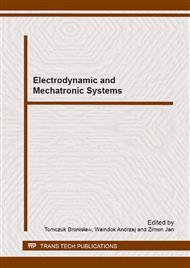[1]
A.J. Moses : Electrical steel: past present and future developments. IEE Proceedings, Vol. 137, Pt.A, Nr 5 (1990) 233-245
Google Scholar
[2]
B.D. Cullity: Introduction to Magnetic Materials. Addison-Wesley Publishing Company (1972)
Google Scholar
[3]
T. Kubota et.al.: Recent progress and future trend on grain-oriented silicon steel. JMMM Vol. 215-216 (2000) 69-73
DOI: 10.1016/s0304-8853(00)00069-x
Google Scholar
[4]
Y. Ushigami et.al.: Recent development of low loss grain-oriented silicon steel. JMMM, Vol. 254-255 (2003) 307-314
DOI: 10.1016/s0304-8853(02)00933-2
Google Scholar
[5]
M. Soiński, A.J. Moses., Handbook of Magnetic Materials, Elsevier Science B.V., Vol. 8 (1994)
Google Scholar
[6]
DAQ M Series, M Series User Manual, National Instruments (2008)
Google Scholar
[7]
IEC 404-3:1999; Magnetic materials. Methods of measurements of soft magnetic properties of electrical steel and type with the use of single sheet tester
Google Scholar
[8]
Pluta W.: Some properties of factors of specific total loss components in electrical steel. IEEE Trans. Magn., vol. 46, no. 2 (2010) 322 – 325
DOI: 10.1109/tmag.2009.2033559
Google Scholar
[9]
R. Bozorth: Ferromagnetism. New York, D. van Nostrand Co, (1956)
Google Scholar
[10]
Yo Sakaki, An approach estimating the number of domain walls and eddy current losses in grain-oriented 3% Si-Fe tape wound cores, IEEE Trans. on Magnetics, 16 no 4 (1980) 569-572
DOI: 10.1109/tmag.1980.1060653
Google Scholar
[11]
F. Fiorillo, A. Novikov, An improved approach to power losses in magnetic laminations under nonsinusoidal induction waveform, IEEE Trans. Magn., vol. 26, no. 5 (1990) 2904 – 2910
DOI: 10.1109/20.104905
Google Scholar
[12]
W. Pluta, Measurements of magnetic properties of electrical steel sheets for the aim of loss separation., Journal of Electrical Engineering, 12 (2011) 122-127
Google Scholar
[13]
K. J. Overshoot, The use of domain observations in understanding and improving the magnetic properties of transformer steels. IEEE Trans. on Magnetics, 12 no 6 (1976) 840 - 845
DOI: 10.1109/tmag.1976.1059118
Google Scholar
[14]
A. Ferro, G. Montalenti, G. P. Soardo, On linearity anomaly of power losses vs. frequency in various soft magnetic materials, IEEE Trans. on Magnetics , 11 no. 5 (1975) 1341 – 1343
DOI: 10.1109/tmag.1975.1058895
Google Scholar
[15]
G. Berttoti, "Hysteresis in magnetism", Academic Press, (1998)
Google Scholar
[16]
W. Pluta, Directional properties of loss components in electrical steel sheets. presented at 12th International Workshop on 1 & 2 Dimensional Magnetic Measurement and Testing, 2012, Vienna, Austria
Google Scholar


